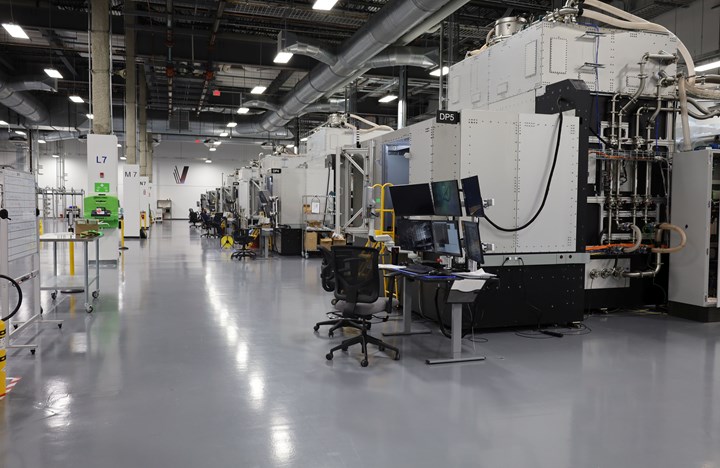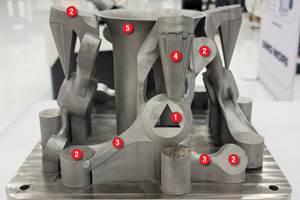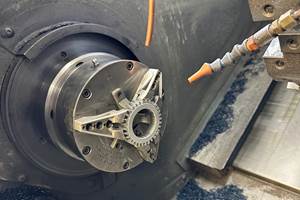How Additive Manufacturing Could Reach its Next 'Plateau of Productivity'
Integrated digital production set to transform additive manufacturing.
Share




A fleet of 100kW powder bed fusion systems, each with 150 laser beams, that can deliver up to 2MW of power during production is enabling VulcanForms to mass produce metal AM parts. Photo credit: VulcanForms
If you are familiar with the Gartner Hype Cycle, you know that every innovation undergoes a period of excitement that eventually crashes when expectations have outpaced what the technology can really do. As this happens, the new technology moves from the “peak of inflated expectations” into the “trough of disillusionment”, which is often where many new technologies wallow and die. If, however, a technology continues to develop and meet expectations, then it can crawl out of this low point and up the “slope of enlightenment” to gain solid footing in the “plateau of productivity” where the technology finally achieves more realistic expectations.
Additive manufacturing (AM) has been undergoing this hype cycle for over a decade now. In fact, I think we are in AM’s second hype cycle with the first being in the early 1990s when 3D printing found initial commercial success thanks to 3D Systems. The hype of what polymer 3D printing could do back then quickly exceeded the reality of what it was capable of, and many lost interest in the technology once the “prototyping problem” had been solved.
As the era of metal 3D printing dawned in the early 2010s, we entered a new hype cycle under the guise of additive manufacturing (AM), which enabled layer-wise fabrication of functional metal parts and end-use components. To change the perception, 3D printing was rebranded as AM to indicate that it could now compete with other manufacturing technology (e.g., subtractive and formative processes) to produce end-use parts.
As with any new technology, though, the hype again outpaced the reality, especially in terms of cost. Part of this was rooted in the lack of understanding that we had about metal AM processes (e.g., powder bed fusion, directed energy deposition), increasing uncertainty and risk of use and adoption. We simply did not yet have hundreds (or thousands) of years of experience with AM like we did with subtractive and forming processes, respectively, and no one wanted to repeat the mistakes that set back other manufacturing innovations.
As if the added risks were not enough, the economics of AM exacerbated the problem. The hype was driven by what I and a colleague dubbed “economies of one” in manufacturing, namely, the ability to produce customized or tailored parts on demand via increasingly small lot sizes at a reasonable cost. The financial benefits arose from the unique economic drivers behind AM. While things looked good on paper, in reality, the costs of machines (and subsequent build time of a part), metallic powder feedstock, post-processing, etc. drove costs so high that few AM business cases made sense.
Thankfully, some companies were not deterred, particularly in the aerospace and medical industries where weight savings and geometric complexity were easily translated into added value worth the extra cost, particularly with expensive materials like titanium. Meanwhile, the defense industry pursued AM as a solution to improve logistics and sustainment of legacy systems in its aging fleets. Combined, this incentivized federal and corporate investments that led to the development of new standards, reductions in material costs, and improvements in machine reliability and throughput, allowing more and more companies to climb the “slope of enlightenment” and reach the hallowed “plateau of productivity.”
Achieving this plateau is also getting easier thanks to advancements in multi-laser systems (e.g., Velo3D’s Sapphire XC 1MZ with 8 1kW lasers, SLM Solutions’s NXG XII 600 with 12 1kW lasers). Even though more lasers does not always translate into cheaper parts, it does improve throughput and reduce lead-time. Increase that to 150 lasers delivering 100 kW of power like VulcanForms recently announced, and you begin to see entirely new plateaus of productivity that were previously unobtainable. (Full disclosure, I advise VulcanForms and have received a small equity stake for my help.)
While VulcanForms may seem like just another step in the ongoing “laser wars” of powder bed fusion providers, it is actually the first time a company is not focused on making better AM systems to sell to other companies to make AM parts. Instead, VulcanForms is making better AM systems to make faster, cheaper, and better AM parts. It is worth repeating: their goal is not to produce better and faster AM systems; their goal is to establish fully integrated digital manufacturing foundries that enable additive mass production.
At first blush, this may not sound much different, but in reality, it completely changes your mindset when your entire business is built on producing AM parts, not selling AM machines. It reminds me of when Henry Ford realized the productivity gains that could be made when the parts moved to the workers (via the assembly line) versus the workers moving to the parts. This too may not have seemed like much of a shift at the time, but as more and more capabilities were vertically integrated (did you catch that VulcanForms acquired Arwood Machine Corporation as they built up their digital production capabilities), a new plateau of productivity was achieved, giving birth to mass production and the industrial revolution of the 20th Century.
Only time will tell if the shift in thinking by VulcanForms will usher in the AM boon like Ford did with the moving assembly line, but productivity is certainly shifting to a new plateau!
Related Content
Designing a 3D Printed Part with Machining in Mind
Designing extra stock and mounting features into a 3D printed part can aid in machining processes downstream.
Read MoreWhy This Moldmaker Thinks Every Shop Needs a 3D Printer
See how this mold shop uses polymer, carbon fiber and metal 3D printers to boost precision and productivity.
Read More6 Trends in Additive Manufacturing Technology
IMTS 2024 features a larger Additive Manufacturing Pavilion than ever before, with veteran suppliers alongside startups and newcomers at the front of the West Building. As you browse these exhibitors, as well as booths found elsewhere at the show, keep an eye out for these trends in AM.
Read MoreChuck Jaws Achieve 77% Weight Reduction Through 3D Printing
Alpha Precision Group (APG) has developed an innovative workholding design for faster spindle speeds through sinter-based additive manufacturing.
Read MoreRead Next
OEM Tour Video: Lean Manufacturing for Measurement and Metrology
How can a facility that requires manual work for some long-standing parts be made more efficient? Join us as we look inside The L. S. Starrett Company’s headquarters in Athol, Massachusetts, and see how this long-established OEM is updating its processes.
Read More


























